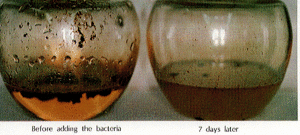Gulf of Mexico oil spillCan microbes break down oil washed onto Gulf beaches?
Nature provides its own methods for keeping sandy beaches clean: microbial communities which are native to the sands; researchers are studying whether native oil-eating bacteria that wash ashore with the crude are helping or hindering these native microbial communities

On left, oil in water, on right, oil in water seven days after introduction of "oil-eating" bacteria // Source: go.jp
A new Florida State University study is investigating how quickly the Deepwater Horizon oil carried into Gulf of Mexico beach sands is being degraded by the sands’ natural microbial communities, and whether native oil-eating bacteria that wash ashore with the crude are helping or hindering that process.
What oceanography professors Markus Huettel and Joel E. Kostka learn will enable them to predict when most of the oil in the beaches will be gone. Their findings may also reveal ways to accelerate the oil degradation rate — and speed matters, because toxic crude components that remain buried on Gulf Coast beaches may seep into the groundwater below.
“This enormous oil spill affects hundreds of miles of beaches in the Gulf of Mexico,” Huettel said. “We can remove the oil from the beach surface, but oil is also carried deeper into the sand, and we need to understand what happens to that oil. Preventing groundwater contamination is crucial not only to Gulf Coast residents but also to coastal management and local economies like fisheries and tourism that depend on water quality.”
“We will also study the effect of the dispersant known as Corexit on oil metabolism by natural microbial communities,” Kostka said. “Through contacts in the field, my laboratory has acquired Corexit and source oil from the MC252 (Deepwater Horizon) well head for use in our experiments.”
St. George Island, Florida, and Dauphin Island, Alabama, have served as the primary research sites since early June, when the one-year study began. In addition, the researchers have obtained heavily oiled sand from Pensacola Beach, Florida, and from a barrier island off the Louisiana coast. If warranted by the oil’s movement, they will also collect near-shore water and sediment samples from other Gulf beaches.
Funding for their collaborative research comes from a RAPID (Rapid Research Response) grant from the National Science Foundation.
Huettel and Kostka will analyze sediment cores collected from Gulf beaches to find out how much and to what depth oil washed onto the shore is carried into the sand; how rapidly microbes in the sand are breaking it down; and how the oil pollution may be impacting the structure and function of natural microbial communities that help to protect water quality on the coast.
“We’ll also show how the oil itself alters the transport and filtration of oxygen-rich water into the beach by clogging the sand — and how this clogging and resulting reduced oxygen availability in
